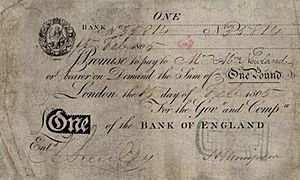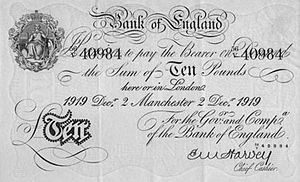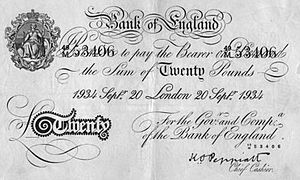Bank of England note issues facts for kids
|
|||||||||||
| ISO 4217 | |||||||||||
|---|---|---|---|---|---|---|---|---|---|---|---|
| Code | GBP | ||||||||||
| Denominations | |||||||||||
|
|||||||||||
| Demographics | |||||||||||
| Users | United Kingdom Jersey Guernsey Isle of Man South Georgia and the South Sandwich Islands St Helena, Ascension and Tristan da Cunha (Tristan da Cunha only) |
||||||||||
| Legal Tender in | England and Wales | ||||||||||
| Issuance | |||||||||||
| Issued by | Bank of England | ||||||||||
| Printer | De La Rue | ||||||||||
The Bank of England is like the main bank for the United Kingdom. It also serves the British Crown Dependencies and British Overseas Territories. This bank has been printing banknotes since 1694.
In 1921, the Bank of England became the only bank allowed to print banknotes in England and Wales. This change started way back in 1844. That's when a law called the Bank Charter Act limited other banks from printing their own money.
At first, banknotes were written by hand. From 1725, they were partly printed, but a cashier still had to sign each one. By 1855, notes were fully printed. Since 1970, Bank of England notes have shown pictures of famous British people.
There are eight banks that can print sterling notes in the UK. But only the Bank of England can print notes for England and Wales. Its notes are considered "legal tender" there. This means they must be accepted for payments. Bank of England notes are not legal tender in Scotland or Northern Ireland, but shops there usually accept them anyway.
Today, the Bank of England prints notes made of polymer (a type of plastic). These come in four values: £5, £10, £20, and £50.
Current Banknotes: What's in Your Wallet?
All the banknotes you see today have a picture of the late Queen Elizabeth II on the front. On December 20, 2022, the Bank of England showed off new notes. These notes have the same designs but feature the new king, Charles III. They are expected to start being used in mid-2024.
There are four different types of notes. Each one has its own colour. Also, the higher the value of the note, the bigger it is. Here are the notes you can find today:
| Image | Value | Size (mm) |
Material | Main Colour | Person on Back | First Issued | ||
|---|---|---|---|---|---|---|---|---|
| Front | Back | |||||||
| £5 | 125 × 65 | Polymer | Turquoise/blue | Winston Churchill, a famous wartime Prime Minister. The note shows his portrait, the Elizabeth Tower (Big Ben), and a quote. | 13 September 2016 | |||
| £10 | 132 × 69 | Polymer | Orange | Jane Austen, a famous writer. The note features her portrait and a quote from her book Pride and Prejudice. | 14 September 2017 | |||
 |
 |
£20 | 139 × 73 | Polymer | Purple | J. M. W. Turner, a famous artist. The note shows his self-portrait and a painting called The Fighting Temeraire. | 20 February 2020 | |
 |
 |
£50 | 146 × 77 | Polymer | Red | Alan Turing, a brilliant mathematician and computer scientist. The note features his photo and an image of his early computer. | 23 June 2021 | |
These images are to scale at 0.7 pixel per millimetre. For table standards, see the banknote specification table.
Special Features of Banknotes
All Bank of England banknotes are printed by a company called De La Rue in Debden, Essex. They have the signature of the Chief Cashier of the Bank of England, Sarah John.
Older notes (Series F £20 and £50) had a hidden watermark of the Queen. But the newer plastic (polymer) notes for £5, £10, £20, and £50 do not have watermarks. Newer notes also have a pattern of yellow circles called the EURion constellation. This pattern helps stop people from copying banknotes with photocopiers.
Queen Elizabeth II has been on all notes since 1960. The idea of putting famous historical figures on the back of notes started in 1970. This was thanks to Harry Eccleston, the Bank of England's first full-time artist.
History of Banknotes
The Bank of England was not always the only bank printing money in England and Wales. For a long time, private banks could print their own banknotes. These notes were used all over the country.
Over the years, new laws were made to make people trust banknotes more. These laws slowly limited which banks could print money. Eventually, the Bank of England became the only one allowed to do so in England and Wales.
Early Banknotes and Gold Shortages
In the 1700s, laws were passed to stop small banking companies from printing notes. This made sure that only larger, more trusted banks could issue money.
During wars in the 1700s, there wasn't enough gold. Gold was usually used for money. Because of this, the Bank of England started printing smaller £1 and £2 notes. People often hid their gold during wartime, so paper money became very important.
Making Notes "Legal Tender"
In 1833, a law made Bank of England notes worth more than £5 "legal tender" in England and Wales. This meant that these notes had to be accepted as payment. This helped people trust the Bank's notes, especially during difficult times.
Later, in 1954, £1 and 10-shilling notes also became legal tender. This law even applied to Scotland. However, because of inflation, the 10-shilling note was replaced by a coin in 1969. The £1 note was also replaced by a coin in 1988. This means there is no paper legal tender in Scotland today, which is a bit unusual!
The Bank of England's Monopoly

The Bank Charter Act 1844 was a big step in giving the Bank of England full control over printing notes. This law said that no new banks could start printing notes. Also, banks already printing notes in England and Wales could not print more than they already did.
Over time, many of these private banks closed or joined with other banks. When they did, their right to print notes disappeared. The very last private banknotes in England were printed in 1921 by a bank called Fox, Fowler and Company.
How Notes Were Printed Over Time
Notes were first written by hand. From 1725, they were partly printed, but a bank worker still had to sign each one. By 1855, notes were fully printed, which was much easier! Until 1928, all notes were plain black on white paper. These were called "Series A" notes.
In 1921, the Bank of England officially became the only bank allowed to print banknotes in England and Wales. This was the end of a long process that began in 1844.
In 1928, the Bank started printing 10-shilling and £1 notes. Before this, the government had printed these notes during World War I. The 1928 notes were the first to have colours and to be printed on both sides.
During World War II, some very high-value notes (like £1,000) were removed from circulation. This was done to stop people from making fake money.
Banknote Values Over Time
The Bank of England has issued many different values of banknotes throughout history. Here are some of them:
| Value | First Issued | Last Issued | Notes |
|---|---|---|---|
| 10/– (ten shillings) | 1928 | 1970 | Replaced by a 50p coin. |
| £1 | 1797 | 1988 | Replaced by a £1 coin. |
| £2 | 1797 | 1821 | Issued to replace gold coins during wars. |
| £5 | 1793 | Still in circulation | |
| £10 | 1759 | Still in circulation | |
| £20 | 1725 | Still in circulation | |
| £50 | 1725 | Still in circulation | |
| £100 | 1725 | 1943 | Some Scottish and Northern Ireland banks still issue £100 notes. |
| £500 | 1725–45 | 1943 | |
| £1,000 | 1725–45 | 1943 |
The 10-Shilling Note
The first 10-shilling note from the Bank of England came out in 1928. It had a picture of Britannia, a symbol of Britain. This note was mostly red-brown. Later, in 1940, a metal security thread was added. The colour was changed to purple during the war.
In 1961, a new design came out with a portrait of Queen Elizabeth II. A new 10-shilling note was planned to feature Walter Raleigh. But because of rising prices, it was decided to replace the note with a coin instead. The 10-shilling note was removed from use in 1970.
The £1 Note
The very first Bank of England £1 note was issued in 1797. This happened because the government needed smaller banknotes to replace gold coins during the French Revolutionary Wars.
The Bank of England's £1 note, after a long break, returned in 1928. It also featured Britannia and was mostly green. Like the 10-shilling note, it got a security thread in 1940 and changed colour to blue and pink during the war. This was to stop fake notes from Germany.
In 1960, the £1 note also got Queen Elizabeth II's portrait. This note was removed in 1979. A new £1 note came out in 1978, featuring Isaac Newton. But like the 10-shilling note, it became too expensive to make. So, it was replaced by a coin and taken out of circulation in 1988.
The £5 Note
The first Bank of England £5 note was issued in 1793. It was needed to replace gold coins during the wars. This early £5 note was known as the "white fiver" because it was black print on white paper. It stayed mostly the same until 1957.
In 1963, the £5 note got Queen Elizabeth II's portrait for the first time. Later, in 1971, a new £5 note featured the Duke of Wellington on the back.
In 1990, a new £5 note was issued. It was turquoise blue and had special features to stop copying. At first, it featured the railway engineer George Stephenson. But a mistake was found (the wrong death year), so a new version was made. In 2002, a new green £5 note came out, featuring the prison reformer Elizabeth Fry.
The £10 Note
The first Bank of England £10 note was issued in 1759. It stopped being made in 1943. In 1964, a new brown £10 note was issued.
In 1975, a new £10 note featured Florence Nightingale, a famous nurse. It showed her working in a hospital during the Crimean War.
In 1992, a new orange £10 note came out, featuring Charles Dickens, a famous writer. Later, in 2000, another £10 note featured Charles Darwin, known for his work on evolution.
A new £10 banknote, featuring the novelist Jane Austen, was issued in 2017. This was important because people wanted to see more women on banknotes. Like the £5 note, this new £10 note is made of polymer (plastic).
The £20 Note
White £20 notes were first issued in 1725 and continued until 1943. They stopped being legal tender in 1945.
In 1970, a purple £20 note was introduced. It featured William Shakespeare and a scene from Romeo and Juliet. In 1991, this was replaced by a note featuring the physicist Michael Faraday. Because this note was often faked, a new design came out in 1999. This one featured the composer Sir Edward Elgar.
In 2006, a new £20 note design was announced. It featured the Scottish economist Adam Smith. This was a bit unusual because he was Scottish on an English note. The new note came out in 2007.
A new polymer £20 note, featuring the artist J. M. W. Turner, was issued in 2020.
The £50 Note
White £50 notes were issued from 1725 until 1943. They stopped being legal tender in 1945.
In 1981, a £50 note featured the architect Christopher Wren and a plan of St Paul's Cathedral. In 1994, to celebrate the Bank's 300th birthday, a new £50 note featured its first governor, Sir John Houblon.
In 2009, a new £50 note design was announced. It featured James Watt and Matthew Boulton, who were important inventors. This note came out in 2011 and was the first to have two portraits on the back. It also had a special security feature called "Motion," which is a hologram that seems to move as you tilt the note.
A new polymer £50 note, featuring Alan Turing, was issued in 2021.
Very High Value Notes
The Bank of England also has some very high-value notes that you won't see in everyday use.
- £500,000 Notes: These were used for special purposes, like when the Bank held money for other countries. They were not for the public.
- £1,000,000 ("Giants") and £100,000,000 ("Titans") Notes: These huge notes are used internally by the Bank of England. They help make sure that banknotes issued by commercial banks in Scotland and Northern Ireland are backed by enough money. They are not for general circulation. Some of these notes were given to British and American officials as special gifts.
See also







